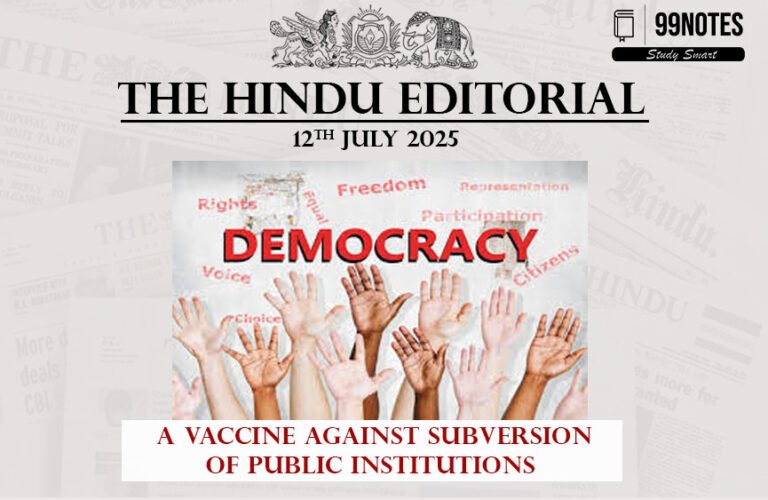21 March 2024 : The Hindu Editorial Notes PDF
The Hindu Editorial
21-March-2024
1. Data marketplaces: the next frontier
| Topic: GS3 – Indian Economy – Effects of liberalisation on the economy. This topic is crucial for UPSC as it addresses governance challenges and potential of Non-Personal Data in India’s digital transformation. |
| Context |
| ● The article discusses the significance of Non-Personal Data (NPD) in India’s digital economy, highlighting challenges in regulation, the need for data exchanges, and examples of initiatives to govern NPD effectively. |
Introduction:
- Digitization plays a crucial role in India’s ambition to become a $5 trillion economy, with data and artificial intelligence (AI) predicted to contribute significantly to GDP growth.
- However, rapid digitization of government operations has led to an increasing volume of citizen data, including Personal Data and Non-Personal Data (NPD).
Significance of NPD:
- NPD, primarily obtained by the government, holds potential as a ‘public good’ and can be integrated into public service delivery to create synergies and scalable solutions.
- Utilizing advanced analytics and AI on NPD across key sectors can help predict socially and economically sound outcomes in areas such as meteorological forecasts, infrastructure capacity, mobility patterns, and employment trends.
Challenges in NPD Regulation:
- Unlike Personal Data, there is a lack of regulation for NPD, leading to unregulated accumulation and limited guidance on dissemination, use, or exchange.
- Efforts at the executive level, including the National Data Governance Framework Policy (NPD Framework), have been made, but there is no enforceable regime for NPD in India.
Issues with Unregulated NPD:
- Unprotected inter-flow of NPD across government departments, third-parties, and citizens can lead to privacy breaches and unfairly benefit capacity-carrying actors like Big Tech.
- Imperfect analysis of public trends can result in faulty decision-making and inefficient data exchange, hindering interdisciplinary legislative and policy-making.
Gaps in the NPD Framework:
- The NPD Framework lacks tangible, actionable guidance and mechanisms for pricing data and facilitating data exchange, leaving questions unanswered regarding stakeholder rights and obligations.
- Standardized governance tools are absent, exacerbating challenges in NPD regulation and interoperability across sectors.
Need for Regulation and Data Exchanges:
- Evaluating the NPD Framework and formulating a blueprint for regulating data exchanges in India is essential to supplement efforts by MeiTY and expert committees.
- This approach aligns with global discourse on data exchange regulation and can facilitate the digitization of public-welfare functions, reducing administrative burden and promoting participatory governance.
Examples and Initiatives:
- Initiatives like the agriculture data exchange in Telangana and India Urban Data Exchange demonstrate budding interest in data exchange structures.
- There is a need to formulate a blueprint for governing data exchanges in India to operationalize high-level principles of NPD governance and facilitate forward-thinking regulation.
Conclusion:
- Developing a regulatory framework for data exchanges in India is crucial for realizing the potential of NPD in driving economic growth and promoting inclusive governance.
- By addressing gaps in existing policies and aligning with global best practices, India can leverage data exchanges to advance its digital economy and enhance public service delivery.
| PYQ: Data security has assumed significant importance in the digitized world due to rising cyber crimes. The Justice B. N. Srikrishna Committee Report addresses issues related to data security. What, in your view, are the strengths and weakness of the Report relating to protection of personal data in cyber space? (250 words/15m) (UPSC CSE (M) GS-3 2018) |
| Practice Question: Discuss the regulatory challenges and potential benefits associated with leveraging Non-Personal Data (NPD) for India’s digital governance. (150 Words /10 marks) |
2. Eliminating diseases, one region at a time.
|
Topic: GS2 – Social Justice – Health This topic holds significance for UPSC as it helps understanding disease elimination strategies, surveillance systems, and regional approaches to address global health challenges. |
| Context |
| ● The article discusses the progress towards the eradication of Guinea worm disease, highlighting the importance of disease elimination strategies, challenges, and the need for robust surveillance systems and regional approaches for successful implementation. |
Introduction:
- Guinea worm disease is close to eradication, showcasing the effectiveness of disease elimination efforts by organizations like the Carter Center.
- Disease elimination is a crucial step towards eradication and aligns with the Sustainable Development Goals set by the United Nations.
Focus on Disease Elimination:
- Elimination of transmission aims for zero transmission in a defined region, distinct from eradication which ensures no risk of reintroduction.
- Disease elimination energizes the public health system, improves primary healthcare, diagnostics, surveillance, and attracts international support.
Challenges and Considerations:
- Disease elimination is resource-intensive and may strain weak health systems, necessitating careful analysis of costs and benefits.
- Strategic planning is vital, focusing on diseases with high impact and low prevalence for feasible elimination.
Importance of Surveillance Systems:
- Investment in robust surveillance systems is crucial for detecting and monitoring disease incidences, strengthening laboratories, and ensuring the availability of medicines.
- Continuation of surveillance post-elimination is necessary to prevent reintroduction of pathogens.
Regional Approach to Elimination:
- Regional elimination strategies facilitate multisectoral collaboration, innovation, and adoption of locally effective solutions.
- Phased elimination at the regional level allows better resource management and progress monitoring, culminating in national eradication.
National Ownership and Support:
- National and State governments should own the elimination process, with the Union government handling cross-border disease spread.
- India’s effective national elimination strategy begins regionally, scaling up progressively across the country.
Conclusion:
- Disease elimination efforts, exemplified by Guinea worm disease, highlight the importance of strategic planning, robust surveillance, and multisectoral collaboration.
- A regional approach to elimination, with national ownership and support, is essential for achieving and sustaining disease-free status.
| Guinea Worm Disease: |
|
● Guinea worm disease (dracunculiasis) is caused by the parasitic worm Dracunculus medinensis. ● Humans contract the disease by drinking water contaminated with water fleas carrying Guinea worm larvae. ● The larvae mature into worms within the human body, growing up to 2-3 feet in length. ● Painful blisters form on the skin as the worm emerges, causing incapacitating pain and secondary infections. Symptoms: ● Painful blister formation on the skin, usually on lower limbs ● Gradual emergence of a long, spaghetti-like worm from the blister ● Intense itching, burning, and swelling around the blister area ● Secondary bacterial infections can occur, leading to further complications Prevention: ● Filtering drinking water to remove water fleas carrying Guinea worm larvae ● Providing access to clean, safe drinking water sources ● Health education to promote awareness about avoiding contaminated water sources ● Encouraging use of water treatment methods such as boiling or chemical disinfection ● Isolating and treating infected individuals to prevent further transmission ● Implementing strict surveillance measures to detect and contain cases promptly. Eradication efforts: ● Eradication efforts led by various organisations have significantly reduced cases from 3.5 million in 1986 to few hundreds in 2023. ● Guinea worm disease is close to becoming the second disease eradicated globally, following smallpox. ●The eradication campaign emphasizes health education, water filtration, and containment of infected individuals to prevent transmission. ● Surveillance and rigorous monitoring are crucial to prevent the reintroduction of the disease. |
| PYQ: Appropriate local community-level healthcare intervention is a prerequisite to achieve ‘Health for All ‘ in India. Explain. (150 words/10m) (UPSC CSE (M) GS-2 2018) |
| Practice Question: Discuss the significance of disease elimination strategies in global health initiatives, citing the example of Guinea worm disease eradication. Evaluate the challenges faced and the importance of robust surveillance systems and regional approaches. (250 Words /15 marks) |
For Enquiry

21 March 2024 : PIB Summary for UPSC

21 March 2024 : The Hindu Editorial Notes PDF

21 March 2024 : Indian Express Editorial Analysis

20 Mar 2024 : Daily Answer Writing

20 Mar 2024 : Daily Current Affairs Quiz

20 March 2024 : Daily Current Affairs

20 March 2024 : The Hindu Editorial Notes PDF

20 March 2024 : PIB Summary for UPSC

20 March 2024 : Indian Express Editorial Analysis

19 Mar 2024 : Daily Answer Writing
March 2024 PIB 21 March 2024 : PIB Summary for UPSC PIB Summary for UPSC
21-March -2024
1. Maiden test-firing of India’s first indigenously-made 1500 HP…
March – The Hindu Editorial 21 March 2024 : The Hindu Editorial Notes PDF The Hindu Editorial
21-March-2024
1. Data marketplaces: the next frontier
Topic: GS3 – Indian Economy…
Indian Express 21 March 2024 : Indian Express Editorial Analysis Indian Express Editorial Analysis
21-March-2024
1. A border runs through it
Topic: GS2 – International…
mains answer writing 20 Mar 2024 : Daily Answer Writing Mains Answer Writing
20-March-2024
Q1) Without economic growth, capacity building and job creation,…
Daily Quiz 20 Mar 2024 : Daily Current Affairs Quiz 20 Mar 2024 : Daily Quiz…
Daily Current Affairs 20 March 2024 : Daily Current Affairs Daily Current Affairs
20-March -2024- Top News of the Day
1. Delhi Tops World Air Quality Report Again:…
March – The Hindu Editorial 20 March 2024 : The Hindu Editorial Notes PDF The Hindu Editorial
20-March-2024
1. Ties that epitomise India’s neighbourhood first policy.
Topic:…
March 2024 PIB 20 March 2024 : PIB Summary for UPSC PIB Summary for UPSC
20-March -2024
1. Five-day 41st Steering Committee Meeting of International Partnership…
Indian Express 20 March 2024 : Indian Express Editorial Analysis Indian Express Editorial Analysis
20-March-2024
1. An election debate not joined
Topic: GS2 – International…
mains answer writing 19 Mar 2024 : Daily Answer Writing Mains Answer Writing
19-March-2024
Q1) Though grand in their intent the legislative measures for protection…



